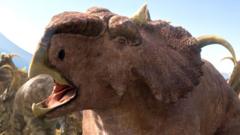Hidden beneath the picturesque slopes of a lush forest in Alberta, Canada, lies a mass grave of enormous proportions. A staggering collection of dinosaur fossils has been unearthed at Pipestone Creek, ominously dubbed the "River of Death," where thousands of dinosaurs met their tragic end in an instant.
A team of palaeontologists has embarked on an investigation of this 72-million-year-old mystery, aiming to reveal how these ancient animals perished. Led by Professor Emily Bamforth, the excavation process begins with the mighty thump of a sledgehammer, necessary to break through the thick rock layers that encapsulate the treasure trove of fossils. As the team begins the painstaking task of clearing away debris, a myriad of bones emerges, shining a light on the life of creatures from a long-lost era.
"This large piece right here appears to be part of a hip," says Prof. Bamforth, as her team unearths more bones, including ribs and toe remnants. The bones predominantly belong to a dinosaur species known as the Pachyrhinosaurus, which features in a new documentary series, Walking With Dinosaurs. These colossal animals, akin to Triceratops in appearance, were roughly five meters long and weighed about two tonnes, equipped with distinctive bony features.
The digging season kicks off with every passing year, typically running until autumn. Prof. Bamforth and her team discover that the bones are densely packed, with the potential of uncovering up to 300 bones per square meter. So far, their excavations have uncovered a plot as large as a tennis court, yet monumental bone beds stretch for a kilometer deeper into the surrounding hillside.
Palaeontology experts speculate that the Pachyrhinosaurus, in a mass migration from the warmer south to the lush northern territories, encountered an unseen disaster that trapped them en masse—an extremely rare fossilized snapshot of an entire community of a single species during a traumatic event.
But Pipestone Creek is not the only site of ancient discovery in the region. A two-hour drive leads to the Deadfall Hills, home to even larger dinosaurs, where palaeontologist Jackson Sweder hunts for fossils effortlessly washed ashore. Here, remnants of the Edmontosaurus, another massive herbivore, paint a broader picture of life in these prehistoric woodlands.
“All our findings come to life back at the Philip J Currie Dinosaur Museum, where we painstakingly clean and examine the bones,” says Sweder, who is currently working on a colossal skull from a Pachyrhinosaurus dubbed "Big Sam."
As the puzzle of these creatures' extinction unfolds, palaeontologists suggest that a sudden natural disaster, such as a flash flood caused by a storm, might have led to this cataclysm. The devastation would have overwhelmed the herd, unable to flee due to their sheer size and top-heavy build.
Embedded within the rock formations at the site are sedimentary patterns revealing swirling waters and destruction frozen in time, hinting at the magnitude of the catastrophe. Each excavation session continues to uncover new facets of this ancient tragedy, fuelling the curiosity and enthusiasm of researchers eager to learn more about the world before they vanished.
With each return to Pipestone Creek, the team is reminded of the endless discoveries waiting to be revealed, as they press on in their quest to illuminate the secrets of these fascinating creatures. The new series of Walking With Dinosaurs premieres on Sunday, providing a unique glimpse into this exhilarating journey through time.



















